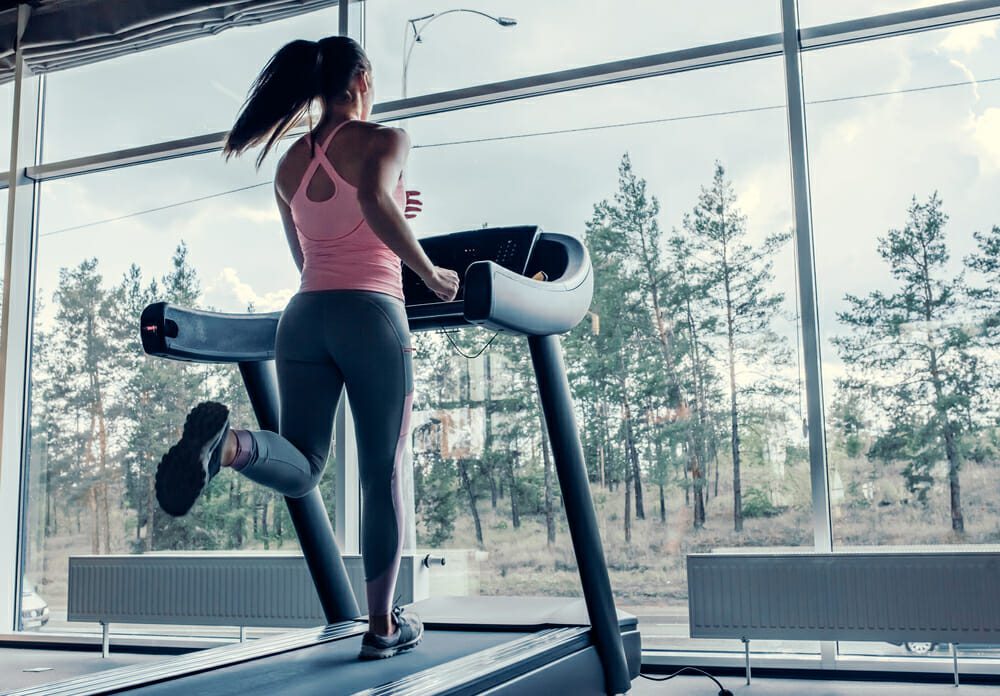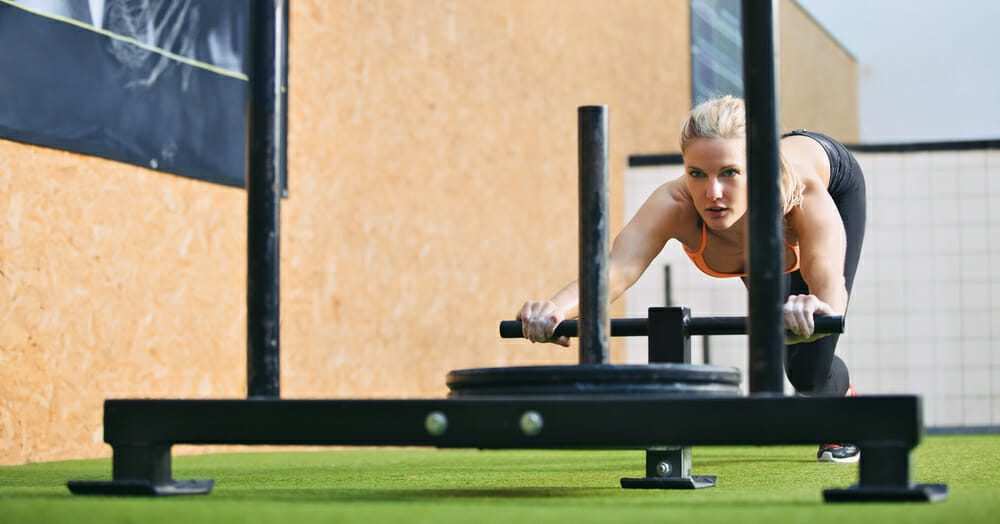Cardiovascular training aka “cardio” has countless benefits for the human body, which we won’t delve into in this article.
However, we do have a serious question for you…
How many times have you seen people get to the gym, hop on a cardio machine, gas themselves to death, and then do resistance training right after?
On the contrary, how many times have you seen someone finish an intense lifting session, then do an intense cardio session right after?
Be honest, have you seen any of these scenarios before?
The questions then become:
- Is it optimal to perform cardio on the same day as a training session?
- Is it more optimal to perform cardio pre or post workout?
- Which cardio modality (type of cardio) is the best to perform to avoid interfering with strength, power, and hypertrophy gains?
First, it’s vital to take goals, activity level, overall health, and training experience into consideration before starting.
Secondly, in this article, we will cover what the cardio interference effect is, cardio modalities you should focus on, reasons to avoid the interference effect, and strategies to practically avoid the interference effect.
So please read this with an open mind—there isn’t a black-and-white answer or an all-or-nothing approach to this.

Let’s dig into this!
What Is the Interference Effect?
The interference effect of strength, power, and hypertrophy gains (muscle growth) when doing cardio pre- or post-workout isn’t a new topic of discussion.
The scientific literature is dense on what is called “concurrent training.” Where one performs resistance training and cardiovascular work together.
In fact, we should be asking, “what is the correct cardio modality to do pre- and post-workout or should we even be doing it at all?”
Fitness expert Brad Schoenfeld says, “There is no one cookie-cutter recommendation I can provide that will be ideal for everyone. People have varying responses to exercise programs. Large inter-individual differences are seen in any research protocol. Thus, in giving advice on a topic such as this, I can only provide general recommendations that must be individualized based on a variety of genetic and environmental factors. This is the essence of evidence-based practice, which should form the basis of every fitness professional’s decision-making process.” [1]
What Cardio Modalities Should You Consider Doing?
There are numerous cardio modalities. Examples of high ground-reaction force forms (those with higher impact) include:
- Conventional sprints
- Up-hill sprints
- Resisted Sprints
- Car pushes
- Prowler Pushes
- Sled Pulls
Examples of cardio modalities that minimize ground-reaction forces are:
- Cycling Bikes
- Treadmills
- Ellipticals
- Various machine-based equipment

These are all great choices whether you use them in the form of high-intensity intervals or low-intensity, but which modality is more optimal to prevent the interference effect and when should you do them?
Layne Norton, Ph.D., and Jacob Wilson, Ph.D., claim that when you choose a cardio modality such as running or sprinting after a resistance training bout, the ground-reaction force (think sprints) and distance cause more muscle damage as opposed to a modality with less impact such as cycling.
Cycling seems to be more similar to hip and knee flexion as opposed to running because it’s biomechanically interfering with squat and leg press patterns. This muscle damage seems to be coming from the eccentric components when running and sprinting. [2],[3]
Norton and Wilson make a valid point that if you are going to do cardio post workout, make sure you do it in the form of an opposing muscle group. Let’s say you did a grueling lower body workout, you would then want to do cardio in the form of using your upper body, something like rope slams or the row machine to avoid an interference effect and possibly get injured.
After resistance training, mTOR (cell growth) is ramped up and protein synthesis (making of new proteins) is stimulated. Cardio after resistance training results in elevated AMP kinase (signaling cascade for ATP production) delaying protein synthesis. In easier terms, cardio after weights interferes with the muscle growth phase.
Pre-workout cardio tends to be a little trickier than post-workout cardio because it depends on factors such as muscle groups trained that day, the intensity of cardio, modality used, and nutritional status—being in a calorie surplus or deficit…trying to lose weight or working for performance only.
A Study in Medicine and Science in Sports and Exercise shows 30 minutes of jogging pre-workout decreases the volume of spinal discs and leads to a reduction in the amount of weight you can load on your back. [4]
For example, if you did a moderate-high intensity cardio bout such as jogging before squats, it’s probably not a good idea because it will lead to decrements in strength and negatively affect your squats. Jogging causes muscle fatigue in the quads, hams, and glutes, so this will definitely affect your workout.
Other Reasons to Avoid the Interference Effect

A 2012 study in the International Journal of Sports Nutrition showed extended periods of moderate volume concurrent strength, power, and endurance training interferes with explosive strength development. This is not something you want if you’re trying to increase your deadlift or squat max. [5]
The data is clear that performing moderate-high intensity cardio pre-workout will reduce strength and power within that immediate bout of resistance training. [6] Perhaps doing cardio earlier in the day and performing resistance training later in the day will not have a negative impact on either the performance or the measured markers of the exercise-induced growth stimulus. However, we encourage doing resistance training and cardio on separate days if maximum strength and muscle gain is your goal.
What if you could burn more calories, increase muscle, and acutely increase your metabolic rate with cardio? This is where high-intensity interval cardio comes into play. When you think of high-intensity, high stress should be taken into consideration. The stress of high-intensity cardio has to be recovered from, just like the stress from weight training.
If you are still recovering from a high-intensity cardio session to the point that it affects your ability to lift weights, it can be detrimental to your gains. If there is a significant eccentric component (sprinting and running), or high level of impact, high-intensity cardio can reduce the effectiveness in your overall training and potentially lead to chronic overuse injuries.
Here Are Some Ways to Avoid the Interference Effect Between Your Cardio And Workout:
- Schedule your cardio around your resistance training, especially high-intensity cardio
- If you must do cardio and resistance training on the same day, then try separating it at least 6-8 hours apart. So, do weight in the a.m and cardio in the p.m
- If you have to do cardio the same day as your resistance training and you can’t find a cardio modality opposite of the body part you trained, then keep the intensity to low-moderate
- If your number one priority is resistance training, then perform cardio modalities that minimize ground-reaction forces
- Perform a cardio modality that is opposite of the muscle group you’re training. For example, if you do train legs then do an upper body-dominant form of cardio and vice versa
Wrap Up
We believe that the research is pretty strong that cardio could negatively impact maximum muscle size and strength, especially if not programmed around resistance training correctly. There is no black and white answer, but at least we have a great indication of what is happening at the tissue level.
Like anything else, there is a tradeoff. Genetics always play a vital role in how someone responds to training. Other factors such as nutrition, stress, sleep, and occupational activity must be taken into account. The best thing to do is choose the correct cardio modality that suits your training and goals and program it properly around your resistance training. And of course, always train hard but, most importantly, train smart.
Ensuring proper nutrition is essential for optimal results when doing any type of cardio and workout program. Use our macros calculator to ensure you get the best results for your workouts.
Originally posted 2019-02-14 17:00:11.

No comments:
Post a Comment